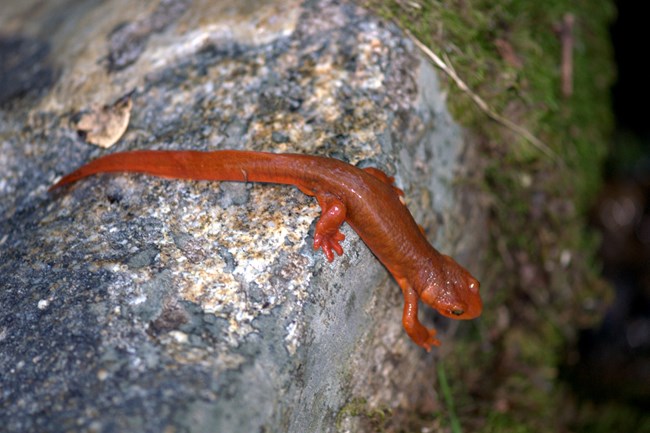
Photo by: © Isaac Chellman Amphibians and fish occur at all elevations within Sequoia and Kings Canyon National Parks. You may see some species only seasonally while others may be found at all times of the year. Their occurrence ranges from common (Pacific treefrogs) to extirpated, or locally extinct (foothill yellow-legged frogs). Mountain Yellow-legged Frogs and Nonnative FishFrom 1870 to 1988, nonnative trout were introduced to high-elevation lakes and streams to make these areas more attractive to anglers. The introduction of fish has had many unintended effects - the most dramatic being the resulting decline in mountain yellow-legged frog populations due to fish predation of frogs and tadpoles and the insects they feed on. Although once lumped together as a single species, mountain yellow-legged frogs have been split into the southern mountain yellow-legged frog (Rana muscosa) and the Sierra Nevada yellow-legged frog (Rana sierra). Both species occur within Sequoia and Kings Canyon National Parks and have disappeared from most of their native range. In 2014, they were listed as endangered under the Endangered Species Act. Although the introduction of trout into frog habitat is still considered a major cause of historic and current declines, the recent epidemic of amphibian chytrid fungus (Batrachochytrium dendrobatidis) has resulted in a another wave of population crashes, and appears to be the primary threat to the remaining populations of frogs occupying fishless habitat. Visit the Mountain Yellow-legged Frogs page to learn more about efforts to restore populations of these frogs to some of the parks' lakes and watch a short video about this project.

Photo by Tony Caprio Other AmphibiansIn addition to the two endangered species of mountain yellow-legged frogs and the extirpated foothill yellow-legged frog, eleven other amphibian species live in these parks. They include:
Many species of amphibians have a limited distribution and thus are vulnerable to disturbance or changing conditions. Slender salamanders, for example, live in specific habitats small in extent, and there may not be comparable places for them to expand their range if warming climate or disturbance such as severe wildfire cause significant changes. 
Andy Harrison FishFollowing are the native species of fish documented for the parks:
An additional six species of nonnative fish occur in the parks, the three most common being California golden trout, brook trout, and brown trout.
Historically, native fish species lived only in the lower elevation reaches of the Kaweah, Kern, and Kings Rivers, typically below 6,000 ft (1,800 m) in elevation. As a result of the introductions of nonnative fish into high-elevation lakes, 550 of the parks' 3,500 previously fishless lakes, ponds, and marshes have self-sustaining populations of trout. Although trout are being removed from a subset of these lakes to restore the native yellow-legged frogs, hundreds of lakes will continue to support trout and provide recreational angling opportunities. |
Last updated: October 3, 2023
